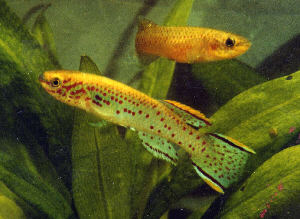Abuja

Wild male collected in the Tarka
River, Abuja.
Photo from BKA newsletter No.238, June 1985 reprinted with permission from Brian
Sell.
|
Codes
|
None known. Also known as Tarka River. | ||||||
|
History
|
First records of this population are from the
DKG (referenced below) where Thomas Schulz visited the site beginning
2008. This population was brought back to the UK in
1985 by Clive Charlton, a worker in an open cast mining company who
distributed them to BKA members in the Cornwall area. |
||||||
|
Habitat
|
Abuja is situated about midway between Lokoja,
at the confluense of the Niger & Benue Rivers to the south, &
Kaduna to the north.
The biotope was at the base of a small cateract
& had a flow of a few gallons per minutehad a lot of green weed
& algae. Also found were a small barb sp. |
||||||
|
Images
|
|
||||||
|
Traits
|
Fish
bred from the original wild stock were reported to grow to a maximum size
of only 50 mm. Although the biotope was reportedly seasonal, eggs in aquaria hatched in 14 days, with young reported as being slow growers taking 3 months to attain 1". |
||||||
|
Variability
|
Fairly
low although the blue phenotype has not been observed in captivity in
recent years. The anal fin, as is common in many gardneri populations can change from 'red bar' to 'spotted'. Spots on body can also be seen as small or heavy. |
||||||
|
Notes
|
In a follow up article in BKA newsletter No.248, April 1986 (see also No.238) Brian Sell reported getting some blue phenotypes showing a blue edge to the anal fins from the fish originally collected by Clive Charlton's steward from the second collection. On borrowing Clive's original stock following the loss of his male he raised 20 young, 5 of which were males, all of which had yellow anal fins. |
References: Über eine neu importierte Form aus dem Fudulopanchax gardneri Formenkreis. Jörg Rückle. DKG Journal - 42. Jahrgang, Heft 1, Februar 2010.